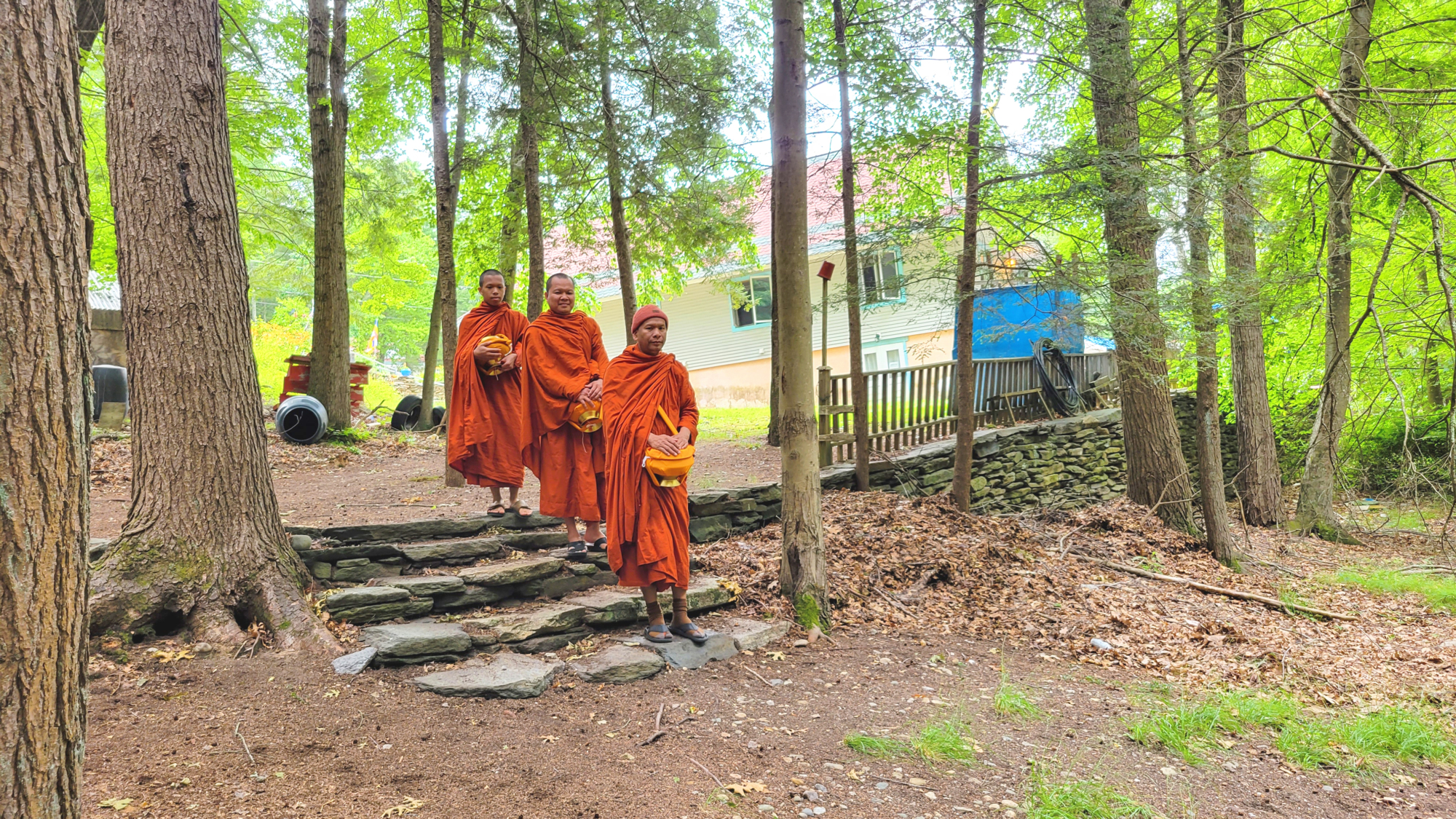
Bhikkhu Buddha Saddha Vey Ve, Bhikkhu Indajoto and Samanera Ananda at the Kiryvongsa Bopharam Buddhist Temple, the Peace Meditation Center.
The Teaching of the Buddha is concerned with more than intellectual knowledge for it needs to be experienced as truth in one’s own life. The Buddha often called his Teaching the Dhamma-Vinaya and when he passed away he left these as the guide for all of us who followed. As Venerable Thiradhammo writes:
In simple terms we could say that while Dhamma represented the principles of Truth, the Vinaya represented the most efficacious lifestyle for the realization of that Truth. Or, the Vinaya was that way of life which enshrined the principles of Truth in the practicalities of living within the world.” (HS Part 2)
For the bhikkhu, the Vinaya helps to highlight actions and speech, and show up their significance. It brings an awareness of how he is intervening in the world, how he is affecting other people. For better? For worse? With what intention?
Of course, such an awareness is necessary for every human being, not just Buddhist monks. This is why the Buddha bequeathed to us the Five, the Eight and the Ten Precepts — as well as the bhikkhu’s 227 rules of the Paatimokkha. These precepts and rules remain as pertinent today as they were 2,500 years ago for they restore the focus back to the human being, to how actions and words affect individuals and the world. While the particulars may have changed, the fundamentals remain the same.
Those who take the Buddha’s Teaching seriously become ever more aware of their actions and speech, and how they match up against the Five Precepts. They then might start to realize the advantage in occasionally keeping the Eight Precepts — perhaps on the weekly Observance Day] — and become more interested in the bhikkhu’s Rule and how its precepts come together into a whole way of life.
This compilation, therefore, is for anyone interested in bhikkhus and how to relate to them. Some might think that the Theravaada lineage follows an overly traditionalist[6] approach but then, it does happen to be the oldest living major tradition. A slight caution therefore for anyone completely new to the ways of monasticism, for it is an approach to dealing with life that may appear radically different for this modern day and age. The best introduction, perhaps essential for a true understanding, is meeting with a practicing bhikkhu who should manifest and reflect the peaceful and joyous qualities of the bhikkhu’s way of life.
Buddhist monks and nuns first received the going-forth into the Holy Life from the Buddha himself, more than two and a half thousand years ago in India. Since then, their influence has been felt over much of Asia. The countries of Sri Lanka and South East Asia have been profoundly affected by the Theravadin School of Buddhism, which looks back to the original Teachings as recorded in the Paali[8] scriptures. Buddhism was often first introduced to a new country when bhikkhus were invited to come and teach the new religion by the indigenous ruler. This process now continues throughout the world, although the invitation nowadays comes more often from local Buddhists.
Buddhism is justly admired for its appreciation of tolerance and broad-mindedness, with a history generally unblemished by heretical infighting. This has resulted in a wide spectrum of practices, from the old Theravada to the Zen of Japan and the Vajrayana of Tibet. Even between the different Theravadin countries and Schools there are slight variations in the ways the bhikkhus understand and practice the Vinaya Rule. Such differences have sometimes confused lay devotees so this book is also an attempt to offer a clearer understanding about the responsibilities of the Theravadin bhikkhu’s life and those of the lay devotee.
When the Buddha was about to finally pass away and leave his followers, rather than appoint an individual to take his place he said this:
“Whatever Dhamma and Vinaya I have pointed out and formulated for you, that will be your Teacher when I am gone.” (Mahaaparinibbaana Sutta, [D.16])
More than twenty-five centuries have now gone by; empires have come and gone, great movements and ideologies have flared up and been lost. Yet on a deeper level under all of this, the Dhamma and Vinaya have been quietly guiding the communities of Buddhist monks. Why has it withstood the test of time so well? Why has it been so successful? Perhaps it is because the Lord Buddha understood the basic human condition of every time or place; he knew our predicament and failings, and he could show the way out to those of us who follow so long after him.
A Guide for Laypeople compiled and explained by Bhikkhu Ariyesako
Source: “The Bhikkhus’ Rules: A Guide for Laypeople”, compiled and explained by Bhikkhu Ariyesako. Access to Insight (BCBS Edition), 17 December 2013, http://www.accesstoinsight.org/lib/authors/ariyesako/layguide.html







Swarnalatha Kuma
Good morning dear jendhamuni..happy to hear you
Jendhamuni
Good morning! Have a most joyous weekend.